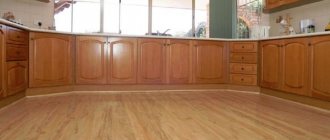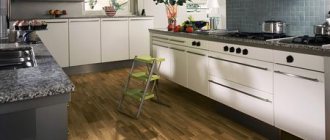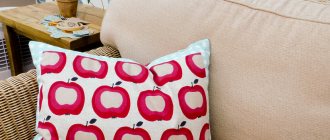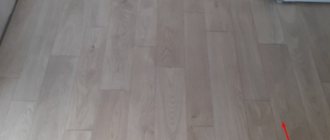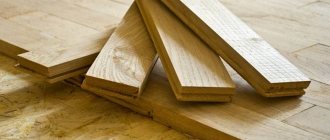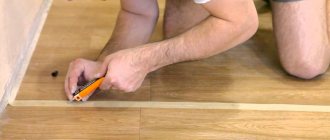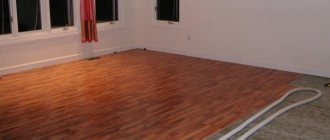We are accustomed to the fact that several floor coverings rarely coexist in one room. The exceptions are often long corridors and studio rooms, which are forced to combine beautiful wood flooring and ceramic tiles. We want to dispel these stereotypes and show that, in fact, such combinations are very relevant and look very interesting. To confirm these words, let's look at several examples of successful interweaving of several materials in different compositions on the floor.
When working with a combined flooring method, the main thing you should think about is the joints. You should definitely discuss your ideas with the foreman in advance and find out from him the most aesthetic methods for decorating seams. Today, the most inconspicuous method can be considered the method of laying a thin strip of cork at the joints - its color can be matched to a wooden covering.
Cork is also good because it is flexible and pliable - and when working with “floating floors” (this includes parquet, parquet boards, and cork broken into dies). Otherwise, you will have to place metal strips about two centimeters wide at the joints.
Inserts synchronous with the wall pattern
If the wall layout of tiles or other covering requires repetition or continuation of the pattern along the floor plane, this can be done by combining the same ceramics and wood. In this case, make sure that the tiles are universal and suitable for use on both floors and walls (floor tiles are always stronger and thicker), or select items from the same collection that are identical in appearance. You can do the same with wood.
2
Why do people prefer to lay laminate flooring instead of tile?
There are several reasons, all of them relate to the advantages that distinguish laminate from tiles. And the main one, which we already mentioned at the beginning, is its more pleasant surface. Laminate flooring is not so cold to the touch, so your feet don’t get cold when walking on it. Although its top layer is artificial, more than 90% of its structure is made from recycled wood, which makes it relatively warm. Therefore, anyone who doesn’t like slippers will now be able to do without them on such a surface. Of course, in terms of tactile sensations it cannot be compared with solid wood, but tile is even more inferior in this regard.
Due to the presence of several microlayers of artificial resins on the surface, the laminate has sufficient wear resistance, similar to tiles, so it can be used in places with high loads - the kitchen, hallway, etc.
Where it is inferior to tiles is in water resistance, but for high-quality models made in Europe, this indicator is quite high, which allows it to be used in the kitchen and hallway. This is explained by the high density of the HDF board, which is the base, as well as the presence of a slight chamfer along the perimeter of the planks by many manufacturers.
- How to choose a laminate
- Which laminate is better to choose
Laminate under tiles photo
The next point concerns installation; everyone knows that laminate is installed without fastening to the base - it is laid on a substrate, in other words, it is laid using the floating method. And this, in turn, significantly reduces installation costs, both financially and in time. It is also worth saying that this is a less dirty job and can be done on your own.
If individual boards are damaged, they can always be dismantled and replaced, which cannot be done with tiles.
And another main advantage of laminate is that for relatively little money you can buy floors that imitate expensive stone - travertine, Belgian stone, marble, etc. The actual cost of which varies on average in the range of 3000 rubles/sq.m.
Complex intersections
Using narrow and long wooden boards, you can create entire grids and patterns on the floor. These can be rhombuses, squares, rectangles - you vary the complexity yourself. If desired, you can even achieve a tartan effect on the floor.
When distributing the width of intersections, be guided by the dimensions of the room, the length of the wooden boards and the final arrangement of the furniture - the more space on the floor, the more it makes sense to spend effort and energy on complex patterns. Otherwise, they simply will not be visible.
1
Joining thresholds between tiles and parquet
Metal and plastic inserts are the most reliable and durable method of arranging transitions. If shaped solutions are needed, you can install a flexible joint between the tiles and the parquet . It takes any form. To connect straight edges, metal profiles with a plastic overlay are suitable.
The technology is divided into two methods:
- Joining thresholds with bottom lining. They are used in the process of laying coatings. On one side, tiles are attached to the mortar, and on the other, parquet.
- Overhead thresholds. This method is used if the floor has already been laid. Fastening is carried out using dowels or self-tapping screws.
Plastic linings are available in a variety of shades. You can choose harmonious options for any color scheme.
Ceramic rectangular inserts
A wooden floor, if the boards are laid on a deck, can be interestingly diluted with inserts made of ceramics, stone or mosaics. All you need is to place squares of the same width as the board at the joints, with a certain offset.
Bold souls can use contrasting colors, but even those who don't think it's necessary or beautiful will appreciate the subtle transition between, say, gray oak wood and gray granite with black chips. The difference in texture, color and material will look like a very smart and subtle design move.
1
Alternating stripes
In a room of any shape, one of the most universal solutions can be considered the arrangement of unequal stripes. These could be wide strips of wood and narrow strips of stone, or vice versa. It all depends on the purpose of the room. In any case, remember that when distributing strips and their place on the floor, you need to rely on the final layout and dimensions of the furniture being installed.
What is laminate?
Tiled laminate is a floor covering that is used in almost any interior today. There are no restrictions on style or budget for laminate - it can look equally organic in a classic interior, as well as in modern or high-tech. What properties of laminate make it so popular?
Of course, above all, it is distinguished by practicality and durability. What is laminate? These are thin tiles with a chipboard or wood fiber base, impregnated with melamine resin. This flooring is very durable - but at the same time light and beautiful.
What advantages does laminate flooring boast?
- The laminate is abrasion resistant and can withstand mechanical loads well. You can safely place heavy furniture on it - there will be no dents on the floor, which would probably appear on linoleum. When dragging a sofa or table from room to room, you also don’t have to fear that stripes or scratches will remain on the floor;
- it does not collect excess dust and dirt (especially if treated with a special product) and does not fade under sunlight. And the laminate does not emit any harmful substances into the environment - it is completely safe for human health;
- laminate under tiles perfectly insulates sound and retains heat, providing comfort to the home;
- laminate is resistant to high temperatures. It will not catch fire from a match or a lit cigarette accidentally falling on the floor, and there will be no unsightly scorch marks left on it;
- With good care, laminate can last up to fifteen years without losing its “marketable” appearance.
In addition, unlike many other floor coverings, laminate is very quick and easy to install. With it, replacing floors will not be a long ordeal. Caring for laminate flooring is also very simple - just wash it regularly with non-aggressive products. If desired, the laminate can be treated with special solutions to add shine or with an antistatic effect.
However, good performance is not the only advantage of laminate over other coatings. In the modern world, not only practicality, but also style is becoming increasingly important. And here laminate provides an almost limitless choice of options.
Various designs and patterns
The convenience of laminate flooring lies not only in the wide selection of shades and tones. Its popularity is also due to the huge range of designs and patterns on this flooring. Laminate can imitate almost any surface - parquet, ceramic tiles, stone, wood of various species.
For example, if wooden elements are actively used in the interior - especially if we are talking about a dacha or a country house - then it would be logical to make the floor from wood as well. However, natural wood in this case is not only expensive, but also inconvenient - it requires careful care, it is less resistant to dirt and microorganisms.
In such a situation, laminate becomes a real godsend - a pattern imitating oak or birch planks will fit perfectly into the interior and allow you to fully implement your plan. And such a floor covering will last much longer, and taking care of it is much easier.
The same applies to cases where, according to the design idea, the floor should be made of natural stone. Very few people can afford a “noble” stone from a financial point of view, and then a stone floor will be too cold and uncomfortable. Laminate with a marble or granite texture (or the same laminate “under tiles”) will help achieve unity of style, retain warmth in the house and provide excellent sound insulation. Not to mention the fact that it will cost tens of times less.
Laminate is an excellent design solution when it comes to a children's room. All its advantages in such a situation become especially important:
- a wide selection of colors will allow you to decorate the nursery in joyful and bright colors;
- Considering that the child will definitely drop something and spill it on the floor, the cost-effectiveness of laminate and ease of care will come in very handy;
- laminate does not collect excess dust - this is important for the child’s health;
- laminate is a fairly warm floor covering, and this will avoid accidental colds.
In a word, the combination of practical and aesthetic qualities of laminate makes it an excellent floor covering in any home, no matter what interior style we are talking about.
Tiles of complex shapes and wood
This way of combining tiles and wood can be considered the most interesting. But it is also the most difficult to perform, requiring a lot of time and painstakingness. The main task here will be the competent selection of tile design and a suitable combination of wood texture. But for builders, joints will be an important issue.
Now at the peak of popularity is the “patchwork” tile, for which all the elements are different, as well as the shape of the ceramic - a small hexagon. With this kind of product, complex wood/tile combinations will look especially impressive.
Joints between tiles and parquet made of sealant and liquid cork
This is an inexpensive and simple way. The technology is recommended for designing shaped transitions, for example, a wavy line. Procedure:
- The edges of the floor coverings are sealed with masking tape or lubricated with machine oil. If foam material gets on the surfaces of the coatings, it will be easier to remove.
- Sealant is pumped into the gap between the tiles and the parquet.
- After drying, the excess is cut off with a spatula or a stationery knife.
An important point is to look for a sealant that matches the color of one of the floor coverings. The technology has a significant drawback. The sealant joint is short-lived. Its integrity is quickly compromised, and the material begins to fall out in pieces.
A more durable and reliable option is liquid cork. The technology for arranging transitions is similar to working with sealants.
Center of composition
Understanding in advance exactly where each piece of furniture will be located, you can correctly play up the semantic centers of the room, using combinations of stone and wood on the floor. Initially draw a pattern, select the material with which you will lay it out, and then add a background that will occupy the remaining perimeter of the room. Such an arrangement looks very impressive, but it is fraught with the danger that an unexpected rearrangement on the floor will reveal a not very meaningful arrangement of patterns. That is why treat this installation option with extreme caution.
As you can see, the combination of colors and textures on the floor is very appropriate. Wood and tile (stone) next to each other look especially interesting, complementing each other and emphasizing their beauty. Experiment without forgetting about the technical features. Remember, the most important thing is high-quality execution, because without it, any, even the most brilliant idea, can turn out to be unsightly.
How to lay tiles under laminate
Vinyl tiles are considered to be the easiest to install. Most laminate flooring materials do not require special fitting or trimming of the floor slab. Moreover, PVC slats often have a ready-made adhesive layer on the back side. You just need to level and carefully lay the material so that the width of the joint is the same along the entire length of the lamella.
How to assemble PVC floor panels under laminate
Square tiles are most often assembled using adhesive locks or a backing base. Such panels are usually decorated with the texture of a light, almost white laminate. This allows you to hide and smooth out transitions at the joints, and thereby obtain the most uniform floor covering.
PVC over old tiles
Laying porcelain stoneware and tiles
In both cases, special adhesive compositions based on cement, latex and acrylic are used. The material is applied to the floor with a notched trowel approximately 3-4 mm above the lower edge of the already laid slabs. The tiles are moistened with a primer and laid on glue.
The seams are marked with crosses
In order for a floor lined with laminate floor ceramics to look as authentic as possible, two parameters must be controlled during installation:
- The height of the front surface. The tiles that have just been laid on the glue are covered with a cloth and brought down to the floor level with a rubber hammer. Next, using a building level, check the surface horizon;
- Be sure to clean and level the seam between the panels. The joint must be of a certain thickness so that after the glue has set, it can be filled with a special sealant-grout that matches the color of the laminate.
Some models of floor tiles based on porcelain stoneware are made with trimmed ends; sometimes the wedge cutting has to be done independently on a machine. In this case, the floor decor is laid without finishing the joints. The result is a monochromatic, even floor covering, almost indistinguishable from a real laminate flooring.

